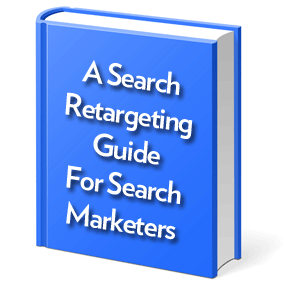A Search Retargeting Guide for Search Marketers
If you are a search marketer, you have probably heard of search retargeting, and most likely, graciously let your counterparts on the display teams take charge. In some ways, search marketers are right in this action, since display advertisers manage campaigns for creative display ads and naturally search retargeting falls into the display camp. Yet, […]
If you are a search marketer, you have probably heard of search retargeting, and most likely, graciously let your counterparts on the display teams take charge.

Search retargeting can be an incredibly effective tool for search marketers who are capped out on search, cannot afford certain keywords, or wish to use more engaging forms of creative.
However, in order for a search retargeting campaign to be successful in the eyes of a search marketer, the proper expectations and understanding must be in place ahead of time.
Here is what you need to know:
1. Search Retargeting Will Not Perform As Well As Search Engine Marketing
Search is the best performing form of online advertising, period. Search marketers must understand that even though search retargeting uses search data, it will not perform as well as SEM.
There are two main reasons for this:
- Search ads appear on the search results page, typically in above the fold position. Since the ad is being shown so soon after the search, click-through rates (CTRs) will usually be higher than search retargeted display media.
- Consumers tend to visit search engines just before they convert, meaning conversion rates will be higher than in display.
Think of search retargeting as an influencer for what consumers type in the search engine and a factor in your search conversion. By no means am I suggesting replacing search.
For example, a customer might search for “plasma TV” in Google, but they will likely click on an organic listing and end up on Best Buy, and other sites over a period of time before they choose the make and model.
During the consideration phase, search data is extrapolated and used to power display advertising (i.e. search retargeting). Eventually, the consumers will make their way back to a search engine, type in a more specific term, such as “Sony Plasma 32″ TV” and then click on a search ad (similar to reason #1 above).
If you were Sony and capped out on keywords, this would be another way to extend the utilization of search data beyond the search engine and influence audiences to take action.
2. Know How To Measure Search Retargeting Campaigns & Give Feedback To Partners
Attribution for a search campaign is easy; if a click leads to a conversion, that click receives credit. However, running a display campaign means dealing with multiple touch points and paths to conversion.
It’s too large a topic to tackle here, so make sure to consider the following points:
- Give some credit to view-through conversions
- Use a smart attribution company like C3 Metrics or Adometry
When you’re running a pay-per-click (PPC) campaign with Google, you can make adjustments and affect performance on the fly from a self-service interface.
When you’re working with a full-service search retargeting partner, optimization is a joint effort between the search marketer and the search retargeting experts. It’s become increasingly crucial to communicate real-time campaign performance so adjustments can be made as needed.
3. Leverage Your Experience & Assets, But Remain Open To New Ideas
If you have been running search engine marketing (SEM) campaigns for a while, you probably have a rotation of high performance text ads. The good news is that existing text ads are easily transferable to search retargeting.
Most search retargeting partners have a system of placing text ads within display boxes, so you can use the existing text ads from any given campaign. However, be sure that these ads are viewable, as most search retargeting companies buy exchange media, which is prone to un-viewable impressions.
Most of all, consider the differences between keyword lists for search, and keyword lists for display. There are many nuances to keyword based display media and in order for SEM to make the leap to display there needs to be a clear, open path to new placements, targeting, etc.
4. Use Ad Verification Software To Monitor Impressions
Since many search marketers do not run display media on a continuous basis, there is hesitation about running exchange media. To prevent such hesitation, use an ad verification company like AdSafe or DoubleVerify. This will help keep your campaigns safeguarded from the “wild wild west” of exchange based display inventory.
According to comScore, consumer search activity is still on the rise, up 7% over the last year. As search grows, prices will increase and the Googles, Bings and Yahoo’s of the world will have greater control over pricing.
Search retargeting is a cost-efficient extension for anyone using search marketing. After all, nobody knows performance-driven media better than search marketers. Instead of passing on an opportunity because it’s associated with display, search marketers should understand the benefits and embrace it.
Contributing authors are invited to create content for Search Engine Land and are chosen for their expertise and contribution to the search community. Our contributors work under the oversight of the editorial staff and contributions are checked for quality and relevance to our readers. The opinions they express are their own.
Related stories
New on Search Engine Land